The Big Ears
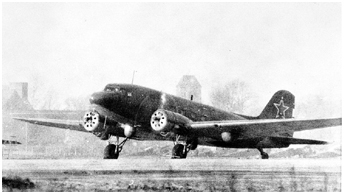
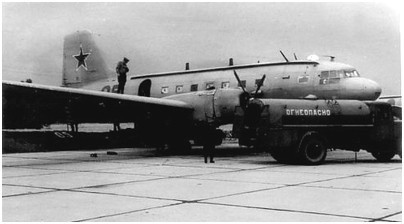 L'Il-14 n°05 photographié à Schönefeld.
© N-E Reznikov.
L'Il-14 n°05 photographié à Schönefeld.
© N-E Reznikov.
The Il-14 n°05 photographed at Schönefeld. © N-E Reznikov.
As was the case for most of the tactical air armies deployed at the borders of the Soviet Empire, besides its three reconnaissance aviation regiments,
the 16.VA also controlled a special detachment that was based at Sperenberg, close to the GSFG Headquarters at Zossen-Wünsdorf.
That separate unit - precisely designated the 39th Separate Reconnaissance Aviation
Detachment (or 39-y Otdel'nyy Razvedvatel'nyy Aviatsionnyy Otryad - 39.ORAO) - was equipped with electronic and photographic
reconnaissance aircraft essentially specialized for listening to, collecting, and analyzing the electromagnetic transmissions.
Despite their mysterious aspect, the aircraft of that detachment were identified. They were two
Il'yushin Il-20M "Coot-A" painted in an overall medium-grey livery (1).
While their careers are fairly well documented - especially considering the very secretive nature of this kind of aircraft as we will see below -
the operational life of their predecessors was totally unknown.
However, thanks to the collaboration of Geoff Hays, a former American photo interpreter and target intelligence officer, and a few
bits of information published here and there in a few Russian forae, we can provide you some details about them along wih some exclusive good-quality pictures.
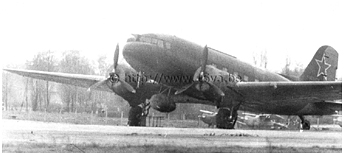
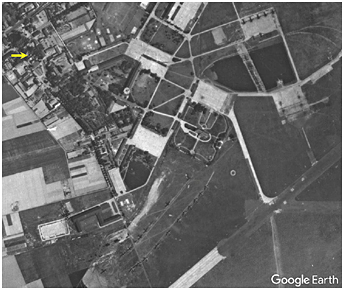 The first Soviet electronic reconnaissance aircraft based in the GDR most likely were Lisunov Li-2 "Cab." The exact designation of these aircraft is
unknown and we will not speculate on this subject.
In 1953, the 197th Separate Guards Transport Aviation Regiment (GTAP) moved from Brandis Airfield where it was based the previous year to Schönefeld
Airfield, located southeast of Berlin. The aerial view of this base shown here dates to 1953. Two rows of Li-2s
(possibly including some C-47s) and a separate parking area occupied by a handful of additional Li-2s can be observed. As you will note after reading the analysis of
the Li-2 picture at the top of this page, this parking area was dedicated to the special Li-2s.
The date of entry into service of these aircraft is unknown; however, when this picture was taken, probably only a few months had passed since their arrival in the GDR.
There appear to be some five to seven aircraft in at least three different configurations here, of which we have identified three by bort
number (2).
One or several aircraft had the following main characteristics: two fairings under the wings and two radomes under the fuselage; two radomes under
the fuselage; a protuberance on the right side of the cockpit and a streamlined pod suspended beneath the front fuselage. If the exact function of the latter remains an enigma,
the protuberance on the cockpit side seemed to be a shifted observation post, suggesting that this Lisunov was a derivative of the FG photogrammetry model.
The first Soviet electronic reconnaissance aircraft based in the GDR most likely were Lisunov Li-2 "Cab." The exact designation of these aircraft is
unknown and we will not speculate on this subject.
In 1953, the 197th Separate Guards Transport Aviation Regiment (GTAP) moved from Brandis Airfield where it was based the previous year to Schönefeld
Airfield, located southeast of Berlin. The aerial view of this base shown here dates to 1953. Two rows of Li-2s
(possibly including some C-47s) and a separate parking area occupied by a handful of additional Li-2s can be observed. As you will note after reading the analysis of
the Li-2 picture at the top of this page, this parking area was dedicated to the special Li-2s.
The date of entry into service of these aircraft is unknown; however, when this picture was taken, probably only a few months had passed since their arrival in the GDR.
There appear to be some five to seven aircraft in at least three different configurations here, of which we have identified three by bort
number (2).
One or several aircraft had the following main characteristics: two fairings under the wings and two radomes under the fuselage; two radomes under
the fuselage; a protuberance on the right side of the cockpit and a streamlined pod suspended beneath the front fuselage. If the exact function of the latter remains an enigma,
the protuberance on the cockpit side seemed to be a shifted observation post, suggesting that this Lisunov was a derivative of the FG photogrammetry model.
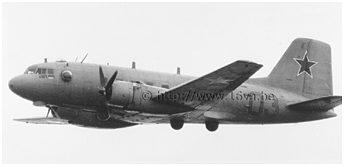 The special "Cabs" would have been on strength with a Separate Reconnaissance Aviation Squadron (ORAZ) that became the 39.ORAO in 1973 (that seems to coincide with the
arrival of the Il-20M).
In August 1953, the 226th Separate Composite Aviation Regiment (OSAP) vacated the Dallgow Airfield (Berlin-Staaken) for Schönefeld,
while the 197.GTAP moved to Trollenhagen.
In the late 1950s, the Li-2 were replaced by at least four modified Il-14s (3) in three different configurations:
four radomes under the fuselage; three radomes, plus a radome under the nose apparently disassembled; and a configuration like the previous one, but with only two radomes.
Various antennas also were mounted above and below the fuselage. All 226.OSAP and ORAZ aircraft finally left Schönefeld in 1960 to settle in Sperenberg until
the final withdrawal from Germany.
The special "Cabs" would have been on strength with a Separate Reconnaissance Aviation Squadron (ORAZ) that became the 39.ORAO in 1973 (that seems to coincide with the
arrival of the Il-20M).
In August 1953, the 226th Separate Composite Aviation Regiment (OSAP) vacated the Dallgow Airfield (Berlin-Staaken) for Schönefeld,
while the 197.GTAP moved to Trollenhagen.
In the late 1950s, the Li-2 were replaced by at least four modified Il-14s (3) in three different configurations:
four radomes under the fuselage; three radomes, plus a radome under the nose apparently disassembled; and a configuration like the previous one, but with only two radomes.
Various antennas also were mounted above and below the fuselage. All 226.OSAP and ORAZ aircraft finally left Schönefeld in 1960 to settle in Sperenberg until
the final withdrawal from Germany.
| ORBAT 1945 - 1993 |
"Coot" Enter the Scene
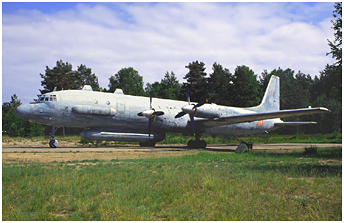
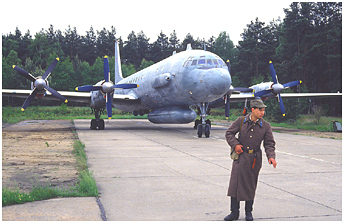 The Il-20, derived from the Il-18D "Coot" airliner, was only observed for the first time by the Western
intelligence services in 1978.
The Il-18D was the latest civilian variant equipped with additional fuel tanks and more economical AI-20M serie VI turboprops.
The range was increased to 6400 km compared to 4850 km for the older Il-18V. The first flight of a "Coot-A" (a modified Il-18D designated
Article 20) took place on March 21, 1968. Eighteen aircraft were manufactured until 1976 at the Znamya Truda (Labor Banner)
factory at Khodinka. The "Coot-A" would be developed into three versions: Il-20 (Article 20), Il-20M (Article 17) and Il-20M1.
The career of the Il-20 without suffix is unknown. Some sources contend that the first operational version was the Il-20M (M for Modifikatsirovanyy - Modified)
that was in service from 1971 on.
The Il-20M could be recognized at first sight thanks to its enormous ventral pod 10.25 meters long and 1.15 meters wide.
This pod housed the antenna of the large high-resolution Igla-1 (Needle) side-looking airborne radar (SLAR), the images of which
- nearly of photo quality - were recorded on film and therefore could be printed on photo paper. The "Igla" was the first Soviet phased-array radar.
Among various bumps and antennas, the Il-20M also had two large fairings on the forward fuselage cheeks (the air intake of the heat exchanger for the SLAR
radar was located in front of the right one) that hid two 1300 mm A-87P oblique cameras (> Photo)
protected by sliding doors and the antennas of an SRS-4 Romb-4 (Diamond) general ELINT system.
The latter was part of the SIGINT suite aboard the aircraft, since the primary mission of the Il-20M was collecting data about the electromagnetic emissions.
The Romb complex was designed to detect, localize, and identify the frequencies of the radars of the "potential enemy" - as the Soviets generally called NATO forces.
The Il-20, derived from the Il-18D "Coot" airliner, was only observed for the first time by the Western
intelligence services in 1978.
The Il-18D was the latest civilian variant equipped with additional fuel tanks and more economical AI-20M serie VI turboprops.
The range was increased to 6400 km compared to 4850 km for the older Il-18V. The first flight of a "Coot-A" (a modified Il-18D designated
Article 20) took place on March 21, 1968. Eighteen aircraft were manufactured until 1976 at the Znamya Truda (Labor Banner)
factory at Khodinka. The "Coot-A" would be developed into three versions: Il-20 (Article 20), Il-20M (Article 17) and Il-20M1.
The career of the Il-20 without suffix is unknown. Some sources contend that the first operational version was the Il-20M (M for Modifikatsirovanyy - Modified)
that was in service from 1971 on.
The Il-20M could be recognized at first sight thanks to its enormous ventral pod 10.25 meters long and 1.15 meters wide.
This pod housed the antenna of the large high-resolution Igla-1 (Needle) side-looking airborne radar (SLAR), the images of which
- nearly of photo quality - were recorded on film and therefore could be printed on photo paper. The "Igla" was the first Soviet phased-array radar.
Among various bumps and antennas, the Il-20M also had two large fairings on the forward fuselage cheeks (the air intake of the heat exchanger for the SLAR
radar was located in front of the right one) that hid two 1300 mm A-87P oblique cameras (> Photo)
protected by sliding doors and the antennas of an SRS-4 Romb-4 (Diamond) general ELINT system.
The latter was part of the SIGINT suite aboard the aircraft, since the primary mission of the Il-20M was collecting data about the electromagnetic emissions.
The Romb complex was designed to detect, localize, and identify the frequencies of the radars of the "potential enemy" - as the Soviets generally called NATO forces.
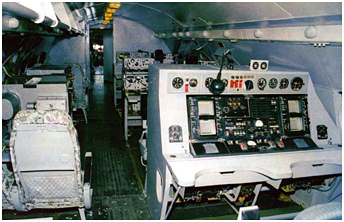 Vue intérieure d'un Il-20M montrant quelques-unes des consoles utilisées par les opérateurs SIGINT.
© A.Mikheyev.
Vue intérieure d'un Il-20M montrant quelques-unes des consoles utilisées par les opérateurs SIGINT.
© A.Mikheyev.
Some SIGINT operator consoles on an Il-20M. © A.Mikheyev.
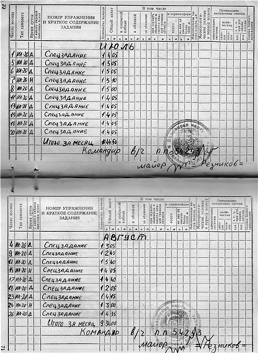 More antennas located on each side of the lower part of the rear fuselage were protected behind three squared radioparent panels. They were related to the
more selective Kvadrat-2 (Square) ELINT system. Besides direction and frequency, the latter suite permitted determination of such parameters as emitter pulse
repetition frequency, pulse repetition rate, cycle, radiated power, and so forth.
Information could be collected by different systems at the same time in order to improve the quality of the collected data.
In this way, the radar images from the Igla could be supplemented by pictures from the A-87P cameras.
Also, the data gathered by the Kvadrat could be compiled with a radar image of the area where the detected radars were located.
Also, a SRS-5 Vishnya (Cherry tree) COMINT clear-speech intercept system was part of the "Coot-A" SIGINT suite.
This complex could be identified thanks to two conspicuous trapezoidal antennas above the forward fuselage.
Equipment descriptions would not be complete without mentioning three unidentified fairings under the fuselage that could have been associated
with the Kvadrat system.
In addition to the normal crew of five persons, specialized operators were necessary to implement the SIGINT suite.
The "front end" crew was composed of a pilot (aircraft commander), a copilot, a navigator, a radio operator and an engineer, all based at Sperenberg.
A sixth crew member who would have been the crew chief is sometimes mentioned - this is unconfirmed information.
The SIGINT operators were from the 82nd Warsaw Red Banner and Aleksandr Nevskiy Orders Separate Special Purpose Electronic Intelligence Brigade
(82-ya Otdel'naya Varshavskaya Krasnoznamennaya Ordena Aleksandra Nevskogo Radiotekhnicheskaya
Brigada Osobogo Naznacheniya - OrtBr OsN, sometimes written OrtBr OsNaz or entirely with capital letters), based at Torgau.
The special purpose units reported to the Main Intelligence Directorate, better known under the acronym GRU (Glavnoye
Razvedyvatel'noye Upravleniye), i.e. military intelligence. The specialized personnal (who were sometimes conscripts) detached at Sperenberg
comprised the crew in charge of the intelligence operations.
More antennas located on each side of the lower part of the rear fuselage were protected behind three squared radioparent panels. They were related to the
more selective Kvadrat-2 (Square) ELINT system. Besides direction and frequency, the latter suite permitted determination of such parameters as emitter pulse
repetition frequency, pulse repetition rate, cycle, radiated power, and so forth.
Information could be collected by different systems at the same time in order to improve the quality of the collected data.
In this way, the radar images from the Igla could be supplemented by pictures from the A-87P cameras.
Also, the data gathered by the Kvadrat could be compiled with a radar image of the area where the detected radars were located.
Also, a SRS-5 Vishnya (Cherry tree) COMINT clear-speech intercept system was part of the "Coot-A" SIGINT suite.
This complex could be identified thanks to two conspicuous trapezoidal antennas above the forward fuselage.
Equipment descriptions would not be complete without mentioning three unidentified fairings under the fuselage that could have been associated
with the Kvadrat system.
In addition to the normal crew of five persons, specialized operators were necessary to implement the SIGINT suite.
The "front end" crew was composed of a pilot (aircraft commander), a copilot, a navigator, a radio operator and an engineer, all based at Sperenberg.
A sixth crew member who would have been the crew chief is sometimes mentioned - this is unconfirmed information.
The SIGINT operators were from the 82nd Warsaw Red Banner and Aleksandr Nevskiy Orders Separate Special Purpose Electronic Intelligence Brigade
(82-ya Otdel'naya Varshavskaya Krasnoznamennaya Ordena Aleksandra Nevskogo Radiotekhnicheskaya
Brigada Osobogo Naznacheniya - OrtBr OsN, sometimes written OrtBr OsNaz or entirely with capital letters), based at Torgau.
The special purpose units reported to the Main Intelligence Directorate, better known under the acronym GRU (Glavnoye
Razvedyvatel'noye Upravleniye), i.e. military intelligence. The specialized personnal (who were sometimes conscripts) detached at Sperenberg
comprised the crew in charge of the intelligence operations.
 Une partie de l'équipage d'un Il-20M du 39.ORAO.
© A.Melnikova.
Une partie de l'équipage d'un Il-20M du 39.ORAO.
© A.Melnikova.
Part of an Il-20M crew from the 39.ORAO. © A.Melnikova.
There is no reliable information available about that particular crew composition.
At most, we can cite some posts:
- BRK (Bortovoy Razvedyvatel'nyy Kompleks - Embedded Reconnaissance Complex)
commander
- 2 voice intercept-linguist SRS-5 operators, some especially coming from the Foreign
Languages Military Institute (VIIYa - Voyennyy
Institut Inostrannykh Yazykov)
- 1 or 2 Igla system engineer/operator(s)
- 1 or several SRS-4 operator(s)
- 1 or several Kvadrat operator(s)
- 1 intelligence data processing reconnaissance system engineer
The 82.OrtBr OsN was established in 1976 (4),
and the Il-20M would have arrived at Sperenberg in 1974.
Anyway, the aircraft were active in 1976 as some documents mention.
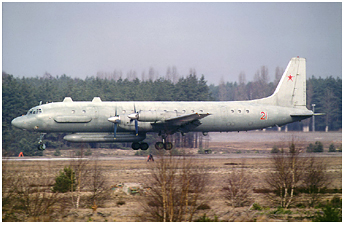
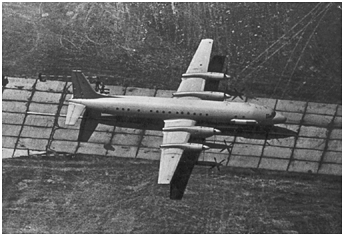 Surprisingly, the "Coot" continued to fly regular missions until 1994. It was reported that they flew
regularly to the Kaliningrad enclave for unknown reasons, although the overflight of Poland by Russian military aircraft
was no longer welcome by the local authorities.
During the Cold War, a typical mission lasted between four and five hours cruising at an altitude of 7300 meters.
A former West German SIGINT opearator wishing to remain anonymous witnessed an unusual mission:
"In the late eighties, we observed a "Coot-A" at only 3000 meters, very close to the Iron Curtain. We saw it from our SIGINT tower
(we went out to watch it when it came within visual range). The "Coot-A" was near the city of Salzwedel heading from east to west.
The "Igla" pod and the antennas of the "Vishnya" system were clearly visible with binoculars. The Il-20M came from the north, flying
southward at 3000 meters (instead of 6700-7300 meters that was the norm for certain patterns), following the border. Of course, all missions
of the IL-20M were monitored, but this one was unusual."
Surprisingly, the "Coot" continued to fly regular missions until 1994. It was reported that they flew
regularly to the Kaliningrad enclave for unknown reasons, although the overflight of Poland by Russian military aircraft
was no longer welcome by the local authorities.
During the Cold War, a typical mission lasted between four and five hours cruising at an altitude of 7300 meters.
A former West German SIGINT opearator wishing to remain anonymous witnessed an unusual mission:
"In the late eighties, we observed a "Coot-A" at only 3000 meters, very close to the Iron Curtain. We saw it from our SIGINT tower
(we went out to watch it when it came within visual range). The "Coot-A" was near the city of Salzwedel heading from east to west.
The "Igla" pod and the antennas of the "Vishnya" system were clearly visible with binoculars. The Il-20M came from the north, flying
southward at 3000 meters (instead of 6700-7300 meters that was the norm for certain patterns), following the border. Of course, all missions
of the IL-20M were monitored, but this one was unusual."
The "Curl" get involved!
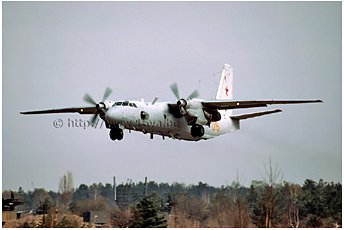
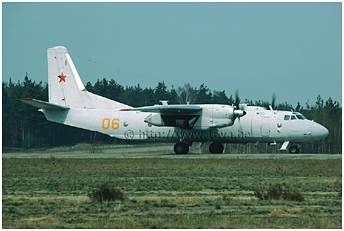 In addition to the 39.ORAO aircraft, Sperenberg also housed two special electronic reconnaissance aircraft that arrived there during the 1980s.
They were two An-26RT or RTR "Curl-B" assigned to the 226.OSAP, mixed together with the other An-26 transport aircraft of the regiment.
There were two "Curl-B" versions difficult to distinguish one from the other. One was an airborne radio-relay variant (RT for Retranslyator) whose fuselage was covered
with antennas. It carried inside its cargo hold an Inzheer (Fig) radio suite used to increase the communications range not only of the ground troops
(armored vehicles, field CP, etc.), but also of aircraft. A 226.OSAP An-26RT(R) sometimes - but not systematically - was observed during withdrawal of an aviation regiment
from Germany to the CIS. It took off before the first waves of combat aircraft and probably was responsible for opening the planned transit air corridors and
coordinating radiocommunications between the migrating aircraft and the ground control stations.
In addition to the 39.ORAO aircraft, Sperenberg also housed two special electronic reconnaissance aircraft that arrived there during the 1980s.
They were two An-26RT or RTR "Curl-B" assigned to the 226.OSAP, mixed together with the other An-26 transport aircraft of the regiment.
There were two "Curl-B" versions difficult to distinguish one from the other. One was an airborne radio-relay variant (RT for Retranslyator) whose fuselage was covered
with antennas. It carried inside its cargo hold an Inzheer (Fig) radio suite used to increase the communications range not only of the ground troops
(armored vehicles, field CP, etc.), but also of aircraft. A 226.OSAP An-26RT(R) sometimes - but not systematically - was observed during withdrawal of an aviation regiment
from Germany to the CIS. It took off before the first waves of combat aircraft and probably was responsible for opening the planned transit air corridors and
coordinating radiocommunications between the migrating aircraft and the ground control stations.
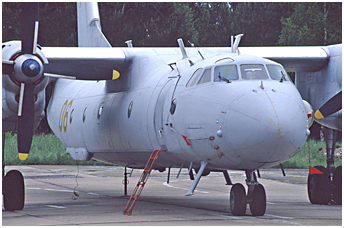
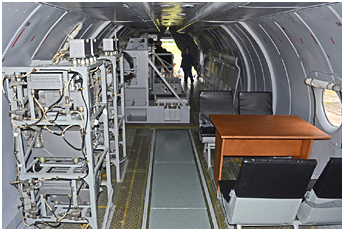 The An-26RT radio-relay variant actually was the second version with the same designation. Another variant very similar externally was a SIGINT collection platform.
More often, this was referred to as An-26RTR (Radiotekhnicheskaya Razvedka - signal intelligence), or, to add to confusion even An-26RR.
One similar aircraft and six radio-relay versions served in Afghanistan. ARZ.308 in Ivanovo converted forty-two An-26 transport aircraft into An-26RT.
However, it is not clear whether this figure includes both RT and RTR versions or not. According to the testimony that you will read in the following paragraph, the
aircraft from Sperenberg were An-26RTR variants. You will discover that they carried out electronic intelligence missions. But, in any case, a radio-relay aircraft by
nature instrumented to intercept broadcasts over a wide range of frequency bands could obviously also be used for intelligence purposes... Curiously, the two An-26RTR
each had a different color code: n°06 (s/n 01510) was orange, whereas n°11 (s/n 01804) was red like the rest of the regiment's fleet. As was the case for the Il-20M of the 39.ORAO,
the An-26RTR left Germany only belatedly.
The An-26RT radio-relay variant actually was the second version with the same designation. Another variant very similar externally was a SIGINT collection platform.
More often, this was referred to as An-26RTR (Radiotekhnicheskaya Razvedka - signal intelligence), or, to add to confusion even An-26RR.
One similar aircraft and six radio-relay versions served in Afghanistan. ARZ.308 in Ivanovo converted forty-two An-26 transport aircraft into An-26RT.
However, it is not clear whether this figure includes both RT and RTR versions or not. According to the testimony that you will read in the following paragraph, the
aircraft from Sperenberg were An-26RTR variants. You will discover that they carried out electronic intelligence missions. But, in any case, a radio-relay aircraft by
nature instrumented to intercept broadcasts over a wide range of frequency bands could obviously also be used for intelligence purposes... Curiously, the two An-26RTR
each had a different color code: n°06 (s/n 01510) was orange, whereas n°11 (s/n 01804) was red like the rest of the regiment's fleet. As was the case for the Il-20M of the 39.ORAO,
the An-26RTR left Germany only belatedly.
The Stasi and the Probes (*)
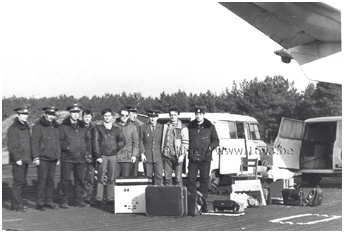 In the 1980s, the Ministry for State Security (Ministerium für Staatssicherheit or MfS, better known as Stasi) several times asked the Soviets to use some
of their aircraft and helicopters for electronic intelligence purposes to supplement their own airborne means. These included Mi-8s of the 239.OGVP from Oranienburg
flying along the West Berlin borders (see > The Mi-8, part 7), the An-26RTR of the 226.OSAP from Sperenberg and one Il-20M of the 39.ORAO. It was during this period
that new types of electronic reconnaissance systems began to be detected from the territory of the GDR . These systems, deployed primarily by the US, were buried near
military targets; they could detect vehicle movements (direction, weight, speed) and then pass on the results in encrypted form by radio via satellite. Such
systems had already been used in the Vietnam War (Operation "Igloo White") and identical devices were found for the first time in the GDR in the 1970s. East German
specialists had been observing the technical evolution of these systems for years and, in 1985, the military intelligence arm of the state security authorities
could pinpoint the location of one that had been under observation since its discovery. It also was later discovered that more devices were hidden not only on the territory
of the GDR, but also in other Warsaw Pact states.
In the 1980s, the Ministry for State Security (Ministerium für Staatssicherheit or MfS, better known as Stasi) several times asked the Soviets to use some
of their aircraft and helicopters for electronic intelligence purposes to supplement their own airborne means. These included Mi-8s of the 239.OGVP from Oranienburg
flying along the West Berlin borders (see > The Mi-8, part 7), the An-26RTR of the 226.OSAP from Sperenberg and one Il-20M of the 39.ORAO. It was during this period
that new types of electronic reconnaissance systems began to be detected from the territory of the GDR . These systems, deployed primarily by the US, were buried near
military targets; they could detect vehicle movements (direction, weight, speed) and then pass on the results in encrypted form by radio via satellite. Such
systems had already been used in the Vietnam War (Operation "Igloo White") and identical devices were found for the first time in the GDR in the 1970s. East German
specialists had been observing the technical evolution of these systems for years and, in 1985, the military intelligence arm of the state security authorities
could pinpoint the location of one that had been under observation since its discovery. It also was later discovered that more devices were hidden not only on the territory
of the GDR, but also in other Warsaw Pact states.
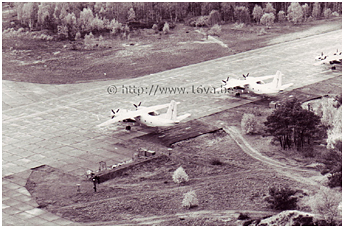 Thus, the responsibility for finding them also fell to the airborne ELINT community. In early 1989, a section of the Main Department III
(5) set up a working group tasked to find these electronic spies designated Sonden (probes)
during special flights to be carried out as part of the Operation "RELAIS V" under the supervision of a KGB liaison officer. Personnel on the ground also had to
participate in the operation and, unlike the other "RELAIS" missions, this one was considered as a defensive rather than an intelligence mission. Before it began,
the emissions of four other probes had been intercepted. The first of approximately twelve flights took place on February 5, 1989. Unlike previous deployments, the
Soviets not only provided aircraft - the An-26RTR of the 226.OSAP - but also SIGINT personnel from the 6th KGB Group. The departure aerodrome was Sperenberg, but further
flights took place from Grossenhain and Merseburg. Except for the antennas of the Antonov, the receivers used for these missions by both the MfS and the
Soviets were of East German origin. Thanks to analyses of the data collected, the transmission schedule of several probes - the latter delivered their data in bursts
lasting only around one second - was discovered. Thus, collection missions could be planned accordingly. The An-26RTRs were not the only aircraft used for these missions. Sometimes
An-26 n°373 of the LSK/LV (> Link) was used, as well as a Mi-8MT from Oranienburg's 239.OGVP (Mi-8 flights
were part of Operation "RELAIS II" that also included collection flights along the West Berlin borders). Helicopter flights originated from the airfields at Oranienburg, Merseburg and
Falkenberg. Finally, the German equipment was loaded aboard Il-20M n°21 of the 39.ORAO. Some missions took place over the territory of the GDR and Czechoslovakia,
where probes also were suspected. On this occasion, the plane and the crew were deployed for a few days at Milovice airfield. As was the case of the An-26RTR platforms, the "Coot" onboard
equipment essentially was not used. Thanks to aerial and, above all, ground reconnaissance, two probes were detected in 1989 and rendered inoperative. In November,
the intelligence services estimated that there still were from three to six probes in the GDR. Even if the fall of the Berlin wall on November 9 put an end to the search for them on the German
side, it is possible that the Soviets continued their investigations with the Il-20M at least until 1992.
Thus, the responsibility for finding them also fell to the airborne ELINT community. In early 1989, a section of the Main Department III
(5) set up a working group tasked to find these electronic spies designated Sonden (probes)
during special flights to be carried out as part of the Operation "RELAIS V" under the supervision of a KGB liaison officer. Personnel on the ground also had to
participate in the operation and, unlike the other "RELAIS" missions, this one was considered as a defensive rather than an intelligence mission. Before it began,
the emissions of four other probes had been intercepted. The first of approximately twelve flights took place on February 5, 1989. Unlike previous deployments, the
Soviets not only provided aircraft - the An-26RTR of the 226.OSAP - but also SIGINT personnel from the 6th KGB Group. The departure aerodrome was Sperenberg, but further
flights took place from Grossenhain and Merseburg. Except for the antennas of the Antonov, the receivers used for these missions by both the MfS and the
Soviets were of East German origin. Thanks to analyses of the data collected, the transmission schedule of several probes - the latter delivered their data in bursts
lasting only around one second - was discovered. Thus, collection missions could be planned accordingly. The An-26RTRs were not the only aircraft used for these missions. Sometimes
An-26 n°373 of the LSK/LV (> Link) was used, as well as a Mi-8MT from Oranienburg's 239.OGVP (Mi-8 flights
were part of Operation "RELAIS II" that also included collection flights along the West Berlin borders). Helicopter flights originated from the airfields at Oranienburg, Merseburg and
Falkenberg. Finally, the German equipment was loaded aboard Il-20M n°21 of the 39.ORAO. Some missions took place over the territory of the GDR and Czechoslovakia,
where probes also were suspected. On this occasion, the plane and the crew were deployed for a few days at Milovice airfield. As was the case of the An-26RTR platforms, the "Coot" onboard
equipment essentially was not used. Thanks to aerial and, above all, ground reconnaissance, two probes were detected in 1989 and rendered inoperative. In November,
the intelligence services estimated that there still were from three to six probes in the GDR. Even if the fall of the Berlin wall on November 9 put an end to the search for them on the German
side, it is possible that the Soviets continued their investigations with the Il-20M at least until 1992.
(*) This section is based on the book by Volker Liebscher entitled "Relais" (see > Multimedia) and his article entitled "Many's Spies" published in the June issue of Aeroplane. Edited with author and editor permission.
A New Life
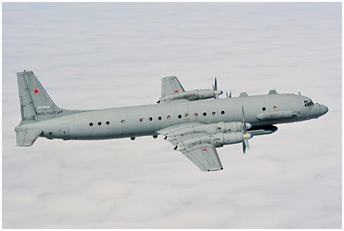 The Il-20M assigned to the 39.ORAO were among the last 16.VA aircraft to depart Germany in 1994.
N°21 took off for the last time from Sperenberg in May, while n°20 departed on June 21 with the combat banner of the 82.OrtBr OsN aboard (this unit was redeployed at Vyaz'ma).
The aircraft landed at Kubinka west of Moscow where they remained operational.
"Noblesse oblige," the very same aircraft that once were on patrol along the inner German border, continue to harass NATO nowadays.
They fly missions along the borders of the Baltic States now under western aerial protection (see > Baltic Air Policing)
or transit through their airspace to rejoin or depart the Kaliningrad enclave. These latter flights indeed require overflight of Lithuania that is authorized under the usual
air navigation procedures. However, the Russians do not always respect their flight plan or fail to power on their transponder to identify themselves, provoking the scramble of the
Western fighters on detached duty at the former Soviet airbase in Siauliai. There is no doubt that some omissions are deliberate in order to test the effectiveness of both the alert system
and the fighters, while at the same time monitoring the different radio emissions generated by these "accidental" intrusions!
While some Il-20M aircraft were modernized during the early 2000s and later, the former aircraft from Sperenberg do not seem to have been upgraded. Their external appearance did not change;
however, this is not necessarily the case internally.
The presence of these electronic intelligence aircraft nearly until the end of the withdrawal of Russian forces from Germany apparently resulted from a particular agreement
between the Bonn and Moscow authorities.
The Il-20M assigned to the 39.ORAO were among the last 16.VA aircraft to depart Germany in 1994.
N°21 took off for the last time from Sperenberg in May, while n°20 departed on June 21 with the combat banner of the 82.OrtBr OsN aboard (this unit was redeployed at Vyaz'ma).
The aircraft landed at Kubinka west of Moscow where they remained operational.
"Noblesse oblige," the very same aircraft that once were on patrol along the inner German border, continue to harass NATO nowadays.
They fly missions along the borders of the Baltic States now under western aerial protection (see > Baltic Air Policing)
or transit through their airspace to rejoin or depart the Kaliningrad enclave. These latter flights indeed require overflight of Lithuania that is authorized under the usual
air navigation procedures. However, the Russians do not always respect their flight plan or fail to power on their transponder to identify themselves, provoking the scramble of the
Western fighters on detached duty at the former Soviet airbase in Siauliai. There is no doubt that some omissions are deliberate in order to test the effectiveness of both the alert system
and the fighters, while at the same time monitoring the different radio emissions generated by these "accidental" intrusions!
While some Il-20M aircraft were modernized during the early 2000s and later, the former aircraft from Sperenberg do not seem to have been upgraded. Their external appearance did not change;
however, this is not necessarily the case internally.
The presence of these electronic intelligence aircraft nearly until the end of the withdrawal of Russian forces from Germany apparently resulted from a particular agreement
between the Bonn and Moscow authorities.
 |
Il-20 interior pictures: 1 / 2 / 3 |
 |
Li-2 / Il-14 / Il-20M / An-26RTR PHOTO PAGE |  |
notes
(1)
Bort nomer 20 s/n 173011502
Bort nomer 21 s/n 173011504
(2)
Bort nomer 10 s/n 18439207 > Assignments
Bort nomer 12 s/n 23441901 > Crashed in 1976
Bort nomer 14
(3)
Bort nomer 03 / 04 / 05 / one uncoded aircraft - all seen at Schönefeld / 06 (according to one report)
(4)
On February 1, 1976, the 82.OrtBr OsN was formed from the 194th Special Purpose ELINT
Regiment (ORTP OsNaz) based at Torgau, the 53rd
Separate Warsaw Red Banner and Aleksandr Nevskiy Orders Special Purpose Radio Regiment (ORadP OsNaz) based at Gera,
and the GSFG
316th Radiofrequency Energy Research Laboratory (LIRI).
(5)
Hauptabteilung III or HA III. It was one of the most important sections of the MfS, responsible for communications intelligence.
Link 1 /
Link 2.
 |
Plan du site - Sitemap |  |
